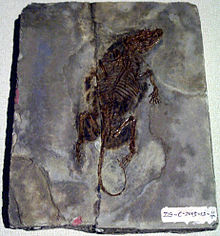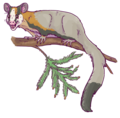Symmetrodonta: Difference between revisions
Luckas-bot (talk | contribs) m robot Adding: ca:Simetrodont |
Thylacine24 (talk | contribs) mNo edit summary |
||
| (47 intermediate revisions by 26 users not shown) | |||
| Line 1: | Line 1: | ||
{{Short description|Extinct order of mammals}} |
|||
{{Taxobox |
|||
{{Automatic taxobox |
|||
| name = Symmetrodonts |
|||
| fossil_range = {{fossilrange|Early Cretaceous|Campanian|latest=Paleocene}} <small>Possible [[Paleocene]] ghost lineage</small> |
|||
| fossil_range = [[Late Triassic]] - [[Cretaceous]] |
|||
| image = Zhangheotherium quinquecuspidens.jpg |
|||
| regnum = [[Animal]]ia |
|||
| image_caption = Fossil specimen of ''[[Zhangheotherium quinquecuspidens]]'' |
|||
| phylum = [[Chordata]] |
|||
| ⚫ | |||
| subphylum = [[Vertebrata]] |
|||
| authority = |
|||
| unranked_classis = [[Amniota]] |
|||
| ⚫ | |||
| classis = [[Synapsida]] |
|||
| ⚫ | |||
| unranked_ordo = [[Mammaliaformes]] |
|||
*{{extinct}}?''[[Chronoperates]]'' |
|||
| ⚫ | |||
| ⚫ | |||
| ⚫ | |||
*{{extinct}}[[Zhangheotheriidae]] |
|||
| ⚫ | |||
* [[Kuehneotheriidae]] |
|||
* [[Spalacolestidae]] |
|||
| ⚫ | |||
* [[Tinodontidae]] |
|||
}} |
}} |
||
'''Symmetrodonta''' is a basal group of [[Mesozoic]] [[mammals]] characterized by the triangular aspect of the [[Molar (tooth)|molar]]s when viewed from above and the absence of a well-developed [[talonid]]. The traditional group of symmetrodonts ranges in age from the latest [[Triassic]] to the [[Cretaceous]]. One species, ''Spalacotheridium noblei'', is notable for its small size. It is one of the smallest known mammals. Each individual molar is little more than 1/100th of an inch across. Symmetrodonta are generally rare and poorly represented in the fossil record. It remains entirely possible they do not represent a discrete phylogenetic category, but with a series of intermediates between [[triconodont]]s, on the one hand, and [[Dryolestoidea|dryolestoid]]s and [[theria]]ns, on the other. At least some genera of symmetrodonts may even be true therians and part of the (disputed) clade [[Trituberculata]]. |
|||
'''Symmetrodonta''' is a group of [[Mesozoic]] [[mammals]] and mammal-like synapsids characterized by the triangular aspect of the [[Molar (tooth)|molar]]s when viewed from above, and the absence of a well-developed [[talonid]]. The traditional group of 'symmetrodonts' ranges in age from the latest [[Triassic]] to the Late [[Cretaceous]], but most research in the last 20-30 years has concluded that they are not a true taxonomic group, but include several unrelated branches of the mammal tree. Despite this, the name is still used informally by some researchers for convenience, usually restricted to the [[spalacotheriids]] and [[zhangheotheriids]].<ref name ="Martin2018"> Martin, T., 2018. 6. Mesozoic mammals—early mammalian diversity and ecomorphological adaptations. In Mammalian evolution, diversity and systematics (pp. 199-300). De Gruyter.</ref><ref name="mengetall2006">{{cite journal | doi = 10.1002/gj.1054 | last1 = Meng | first1 = J. | last2 = Hu | first2 = Y. | last3 = Li | first3 = C. | last4 = Wang | first4 = Y. | year = 2006 | title = The mammal fauna in the Early Cretaceous Jehol Biota: implications for diversity and biology of Mesozoic mammals | journal = Geological Journal | volume = 41 | issue = 3–4| pages = 439–463 | s2cid = 84397126 }}</ref> |
|||
There are some symmetrodonts with acutely-triangulated molar cusps (“acute-angled symmetrodonts”) that seem to form a true [[monophyletic]] group, and lasted from the [[Early Cretaceous]] to the [[Campanian]],<ref>{{cite journal|last1=Bi|first1=Shundong|last2=Wang|first2=Yuanqing|last3=Guan|first3=Jian|last4=Sheng|first4=Xia|last5=Meng|first5=Jin|title=Three new Jurassic euharamiyidan species reinforce early divergence of mammals|journal=Nature|date=2014|volume=514|issue=7524|pages=579–584|doi=10.1038/nature13718|pmid=25209669|bibcode=2014Natur.514..579B|s2cid=4471574}}</ref><ref name="Bi et al 2016">{{cite journal|last1=Bi|first1=Shundong|last2=Zheng|first2=Xiaoting|last3=Meng|first3=Jin|last4=Wang|first4=Xiaoli|last5=Robinson|first5=Nicole|last6=Davis|first6=Brian|title=A new symmetrodont mammal (Trechnotheria: Zhangheotheriidae) from the Early Cretaceous of China and trechnotherian character evolution|journal=Scientific Reports|date=2016|volume=6|pages=26668|doi=10.1038/srep26668|pmid=27215593|pmc=4877676|bibcode=2016NatSR...626668B}}</ref> although [[Zhangheotheriidae]] might be paraphyletic in relation to other forms.<ref name="Bi et al 2016"/> ''[[Chronoperates]]'' has been suggested to be a late surviving representative of this clade,<ref>{{cite journal | last1 = Meng | first1 = J. | last2 = Hu | first2 = Y. | last3 = Wang | first3 = Y. | last4 = Li | first4 = C. | year = 2003 | title = The ossified Meckel's cartilage and internal groove in Mesozoic mammaliaforms: implications to origin of the definitive mammalian middle ear | journal = Zoological Journal of the Linnean Society | volume = 138 | issue = 4 | pages = 431–448 | doi=10.1046/j.1096-3642.2003.00064.x| doi-access = free }}</ref> offering a ghost lineage extending to the late [[Paleocene]]; however, no recent phylogenetic studies have incorporated it. |
|||
Particular sub−groups of Symmetrodonta are better studied, e.g. [[Spalacotheriidae]], which has acute−angled molariform teeth, strongly reduced [[talonid]]s, and conspicuous anterior and posterior [[cingulid]]s. |
Particular sub−groups of Symmetrodonta are better studied, e.g. [[Spalacotheriidae]], which has acute−angled molariform teeth, strongly reduced [[talonid]]s, and conspicuous anterior and posterior [[cingulid]]s. |
||
== |
==Biology== |
||
Though some forms like ''[[Zhangheotherium]]'' retain a [[Meckelian groove]], at least [[Spalacotheriinae]] lost it, acquiring [[Evolution of mammalian auditory ossicles|modern ear anatomy]]. Their deciduous canines and premolars as well as long lower jaw indicate a [[carnivorous]]/[[insectivorous]] diet.<ref>{{cite journal|last1=Han|first1=Gang|last2=Meng|first2=Jin|title=A new spalacolestine mammal from the Early Cretaceous Jehol Biota and implications for the morphology, phylogeny, and palaeobiology of Laurasian 'symmetrodontans'|journal=Zoological Journal of the Linnean Society|date=2016|volume=178|issue=2|pages=343–380|doi=10.1111/zoj.12416|doi-access=free}}</ref> |
|||
* Order '''SYMMETRODONTA''' |
|||
** Family [[Kuehneotheriidae]] |
|||
*** Genus ''[[Kuehneotherium]]'' |
|||
*** Genus ''[[Delsatia]]'' |
|||
*** Genus ''[[Kotatherium]]'' |
|||
** Family [[Spalacolestidae]] |
|||
** Family [[Spalacotheriidae]] |
|||
*** Genus ''[[Spalacotherium]]'' |
|||
*** Genus ''[[Shalbaatar]]'' |
|||
** Family [[Tinodontidae]] |
|||
*** Genus ''[[Tinodon]]'' |
|||
*** Genus ''[[Gobiotheriodon]]'' |
|||
** Family ''[[Woutersiidae]]'' |
|||
*** Genus ''[[Woutersia]]'' |
|||
''[[Zhangheotherium]]'' was specialised to a tree-dwelling lifestyle.<ref>{{cite journal|last1=Chen|first1=Meng|last2=Wilson|first2=Gregory P.|title=A multivariate approach to infer locomotor modes in Mesozoic mammals|journal=Paleobiology|date=2015|volume=41|issue=2|pages=280–312|doi=10.1017/pab.2014.14|s2cid=86087687}}</ref> It shows evidence of tarsal spurs, indicating that, like most non-[[theria]]n [[Mammaliaformes]], at least some symmetrodonts were [[Venomous mammal|venomous]] like the modern [[platypus]].<ref>{{cite journal|author1=Hurum, Jørn H. |author2=Luo, Zhe-Xi |author3=Kielan-Jaworowska, Zofia |year=2006|title= Were mammals originally venomous?|journal= Acta Palaeontologica Polonica|volume=51|number=1|pages= 1–11}}</ref> |
|||
One species, ''[[Spalacotheridium noblei]]'', is notable for its small size. It is one of the smallest known mammals. Each individual molar is little more than 0.25 mm across. |
|||
==See also== |
==See also== |
||
* [[Evolution of mammals]] |
* [[Evolution of mammals]] |
||
==References== |
|||
{{reflist}} |
|||
==External links== |
==External links== |
||
* [http://www.carnegiemuseums.org/cmag/bk_issue/1998/marapr/feat3.htm Discovering a Missing Link] |
* [https://web.archive.org/web/20060118104451/http://www.carnegiemuseums.org/cmag/bk_issue/1998/marapr/feat3.htm Discovering a Missing Link] |
||
{{Mammalia|T.}} |
|||
| ⚫ | |||
{{Taxonbar|from=Q1938798}} |
|||
| ⚫ | |||
[[ca:Simetrodont]] |
|||
[[es:Symmetrodonta]] |
|||
[[it:Symmetrodonta]] |
|||
[[nl:Symmetrodonta]] |
|||
[[pl:Symetrodonty]] |
|||
[[pt:Symmetrodonta]] |
|||
Latest revision as of 09:53, 15 June 2023
| Symmetrodonta Temporal range: Possible Paleocene ghost lineage
| |
|---|---|

| |
| Fossil specimen of Zhangheotherium quinquecuspidens | |
| Scientific classification | |
| Domain: | Eukaryota |
| Kingdom: | Animalia |
| Phylum: | Chordata |
| Class: | Mammalia |
| Clade: | Trechnotheria |
| Order: | †Symmetrodonta |
| Subgroups | |
Symmetrodonta is a group of Mesozoic mammals and mammal-like synapsids characterized by the triangular aspect of the molars when viewed from above, and the absence of a well-developed talonid. The traditional group of 'symmetrodonts' ranges in age from the latest Triassic to the Late Cretaceous, but most research in the last 20-30 years has concluded that they are not a true taxonomic group, but include several unrelated branches of the mammal tree. Despite this, the name is still used informally by some researchers for convenience, usually restricted to the spalacotheriids and zhangheotheriids.[1][2]
There are some symmetrodonts with acutely-triangulated molar cusps (“acute-angled symmetrodonts”) that seem to form a true monophyletic group, and lasted from the Early Cretaceous to the Campanian,[3][4] although Zhangheotheriidae might be paraphyletic in relation to other forms.[4] Chronoperates has been suggested to be a late surviving representative of this clade,[5] offering a ghost lineage extending to the late Paleocene; however, no recent phylogenetic studies have incorporated it.
Particular sub−groups of Symmetrodonta are better studied, e.g. Spalacotheriidae, which has acute−angled molariform teeth, strongly reduced talonids, and conspicuous anterior and posterior cingulids.
Biology
[edit]Though some forms like Zhangheotherium retain a Meckelian groove, at least Spalacotheriinae lost it, acquiring modern ear anatomy. Their deciduous canines and premolars as well as long lower jaw indicate a carnivorous/insectivorous diet.[6]
Zhangheotherium was specialised to a tree-dwelling lifestyle.[7] It shows evidence of tarsal spurs, indicating that, like most non-therian Mammaliaformes, at least some symmetrodonts were venomous like the modern platypus.[8]
One species, Spalacotheridium noblei, is notable for its small size. It is one of the smallest known mammals. Each individual molar is little more than 0.25 mm across.
See also
[edit]References
[edit]- ^ Martin, T., 2018. 6. Mesozoic mammals—early mammalian diversity and ecomorphological adaptations. In Mammalian evolution, diversity and systematics (pp. 199-300). De Gruyter.
- ^ Meng, J.; Hu, Y.; Li, C.; Wang, Y. (2006). "The mammal fauna in the Early Cretaceous Jehol Biota: implications for diversity and biology of Mesozoic mammals". Geological Journal. 41 (3–4): 439–463. doi:10.1002/gj.1054. S2CID 84397126.
- ^ Bi, Shundong; Wang, Yuanqing; Guan, Jian; Sheng, Xia; Meng, Jin (2014). "Three new Jurassic euharamiyidan species reinforce early divergence of mammals". Nature. 514 (7524): 579–584. Bibcode:2014Natur.514..579B. doi:10.1038/nature13718. PMID 25209669. S2CID 4471574.
- ^ a b Bi, Shundong; Zheng, Xiaoting; Meng, Jin; Wang, Xiaoli; Robinson, Nicole; Davis, Brian (2016). "A new symmetrodont mammal (Trechnotheria: Zhangheotheriidae) from the Early Cretaceous of China and trechnotherian character evolution". Scientific Reports. 6: 26668. Bibcode:2016NatSR...626668B. doi:10.1038/srep26668. PMC 4877676. PMID 27215593.
- ^ Meng, J.; Hu, Y.; Wang, Y.; Li, C. (2003). "The ossified Meckel's cartilage and internal groove in Mesozoic mammaliaforms: implications to origin of the definitive mammalian middle ear". Zoological Journal of the Linnean Society. 138 (4): 431–448. doi:10.1046/j.1096-3642.2003.00064.x.
- ^ Han, Gang; Meng, Jin (2016). "A new spalacolestine mammal from the Early Cretaceous Jehol Biota and implications for the morphology, phylogeny, and palaeobiology of Laurasian 'symmetrodontans'". Zoological Journal of the Linnean Society. 178 (2): 343–380. doi:10.1111/zoj.12416.
- ^ Chen, Meng; Wilson, Gregory P. (2015). "A multivariate approach to infer locomotor modes in Mesozoic mammals". Paleobiology. 41 (2): 280–312. doi:10.1017/pab.2014.14. S2CID 86087687.
- ^ Hurum, Jørn H.; Luo, Zhe-Xi; Kielan-Jaworowska, Zofia (2006). "Were mammals originally venomous?". Acta Palaeontologica Polonica. 51 (1): 1–11.





